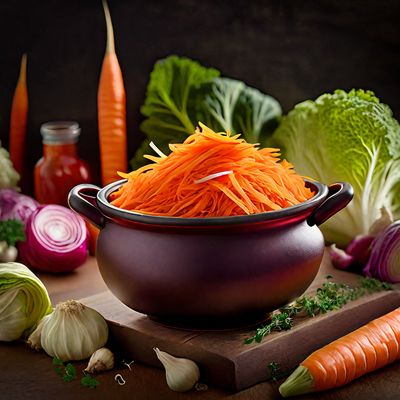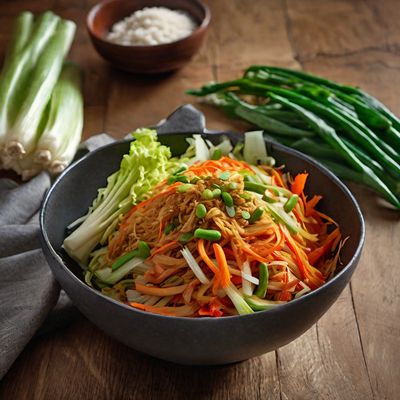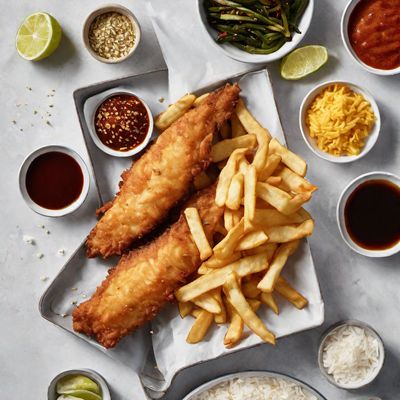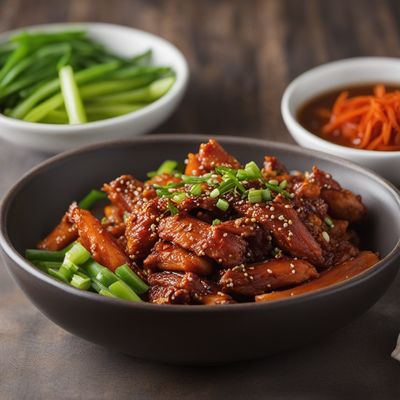
Recipe
Chinese-style Kimchi
Spicy and Tangy Chinese Kimchi: A Fusion of Flavors
4.8 out of 5
In Chinese cuisine, bold flavors and vibrant spices are celebrated. This Chinese-style Kimchi recipe combines the traditional Korean dish with Chinese influences, resulting in a delightful fusion of flavors. The tangy and spicy nature of Kimchi perfectly complements the rich and diverse flavors found in Chinese cuisine.
Metadata
Preparation time
20 minutes
Cooking time
0 minutes (fermentation time: 2-3 days)
Total time
2-3 days (including fermentation time)
Yields
4 servings
Preparation difficulty
Easy
Suitable for
Vegetarian, Vegan, Gluten-free, Dairy-free, Low calorie
Allergens
N/A
Not suitable for
Nut-free, Soy-free, Paleo, Keto, Low-carb
Ingredients
While the original Korean Kimchi is typically made with napa cabbage, Chinese-style Kimchi incorporates a variety of vegetables such as bok choy, radishes, and carrots. Additionally, Chinese Kimchi often includes ingredients like Sichuan peppercorns, ginger, and Chinese five-spice powder to add a unique twist to the traditional recipe. We alse have the original recipe for Kimchi, so you can check it out.
-
1 head napa cabbage, shredded (500g / 1.1lb) 1 head napa cabbage, shredded (500g / 1.1lb)
-
2 bok choy, chopped (200g / 7oz) 2 bok choy, chopped (200g / 7oz)
-
2 large radishes, julienned (150g / 5.3oz) 2 large radishes, julienned (150g / 5.3oz)
-
2 carrots, julienned (150g / 5.3oz) 2 carrots, julienned (150g / 5.3oz)
-
4 cloves garlic, minced 4 cloves garlic, minced
-
1 thumb-sized ginger, grated 1 thumb-sized ginger, grated
-
2 tablespoons Sichuan peppercorns 2 tablespoons Sichuan peppercorns
-
2 tablespoons Chinese five-spice powder 2 tablespoons Chinese five-spice powder
-
4 tablespoons chili flakes 4 tablespoons chili flakes
-
2 tablespoons soy sauce 2 tablespoons soy sauce
-
2 tablespoons rice vinegar 2 tablespoons rice vinegar
-
1 tablespoon sugar 1 tablespoon sugar
-
1 tablespoon salt 1 tablespoon salt
Nutrition
- Calories (kcal / KJ): 80 kcal / 335 KJ
- Fat (total, saturated): 1g, 0g
- Carbohydrates (total, sugars): 16g, 8g
- Protein: 3g
- Fiber: 5g
- Salt: 2g
Preparation
-
1.In a large bowl, combine the shredded napa cabbage, chopped bok choy, julienned radishes, and carrots.
-
2.In a separate bowl, mix together the minced garlic, grated ginger, Sichuan peppercorns, Chinese five-spice powder, chili flakes, soy sauce, rice vinegar, sugar, and salt.
-
3.Pour the spice mixture over the vegetables and toss well to ensure all the vegetables are coated.
-
4.Transfer the mixture to a clean, sterilized jar, pressing down firmly to remove any air pockets.
-
5.Seal the jar tightly and let it sit at room temperature for 2-3 days to allow the flavors to develop.
-
6.After the fermentation period, refrigerate the Chinese-style Kimchi to slow down the fermentation process and enhance its flavors.
-
7.Serve chilled and enjoy!
Treat your ingredients with care...
- Napa cabbage — Make sure to thoroughly wash and dry the cabbage before shredding to remove any dirt or impurities.
- Sichuan peppercorns — Toast the peppercorns in a dry pan over low heat for a few minutes to enhance their flavor before using.
- Chinese five-spice powder — Use a high-quality store-bought blend or make your own by combining equal parts ground star anise, cloves, Chinese cinnamon, Sichuan peppercorns, and fennel seeds.
Tips & Tricks
- For a spicier Kimchi, increase the amount of chili flakes according to your preference.
- Allow the Kimchi to ferment for longer if you prefer a stronger and more tangy flavor.
- Use gloves when handling the chili flakes to avoid irritation to your skin or eyes.
- Adjust the amount of salt and sugar to suit your taste preferences.
- Serve the Chinese-style Kimchi as a side dish, in stir-fries, or as a topping for noodles or rice dishes.
Serving advice
Serve the Chinese-style Kimchi chilled as a side dish alongside your favorite Chinese main course. It pairs well with dishes like Kung Pao Chicken, Mapo Tofu, or Sweet and Sour Pork. The tangy and spicy flavors of the Kimchi will add a refreshing and vibrant element to your meal.
Presentation advice
Present the Chinese-style Kimchi in a small bowl or dish, garnished with a sprinkle of sesame seeds and chopped green onions. The vibrant colors of the vegetables will make the dish visually appealing, and the garnishes will add a touch of freshness.
More recipes...
More Korean cuisine dishes » Browse all
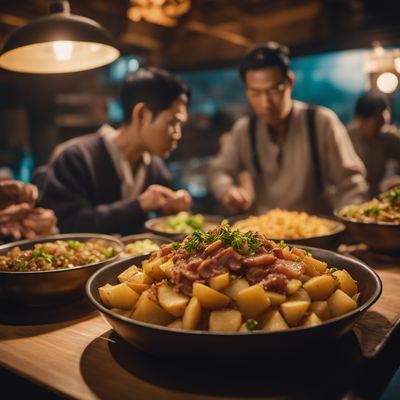
Gamja-haem-bokkeum
Stir-fried potatoes and ham
Gamja-haem-bokkeum is a Korean dish that is made with stir-fried potatoes and ham. It is a popular side dish that is easy to make and is perfect...

Goguma mattang
Candied Sweet Potatoes
Goguma mattang is a traditional Korean dish that is made by caramelizing sweet potatoes. This dish is popular in Korea and is often served as a...

Gaji namul
Eggplant Namul
Gaji namul is a Korean side dish made with blanched eggplant and a soy sauce-based dressing.
More Chinese cuisine dishes » Browse all
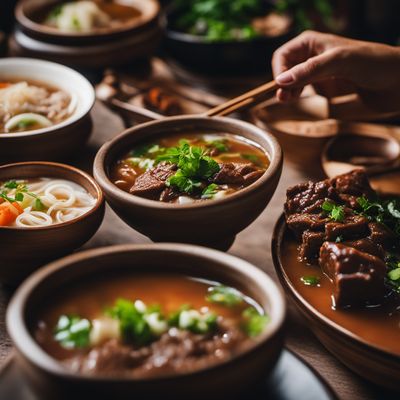
Hulatang
Beef shank soup
Hulatang is a traditional Uyghur soup that is known for its spicy and flavorful broth. It is a perfect dish for cold winter nights and is easy to make.
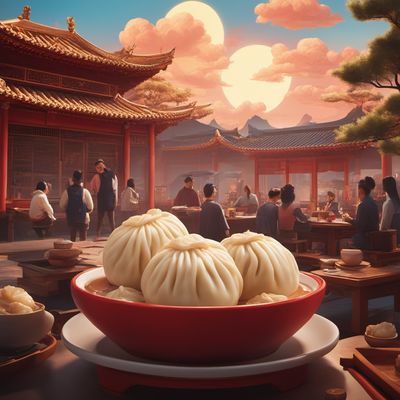
Xiaolongbao
Xiaolongbao is a type of Chinese steamed bun filled with pork and soup.
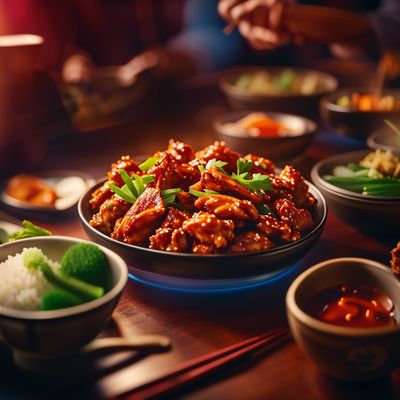
General Tso's Chicken
General Tso's Chicken is a popular Chinese-American dish that is made with crispy fried chicken and a sweet and spicy sauce. It is a flavorful and...
